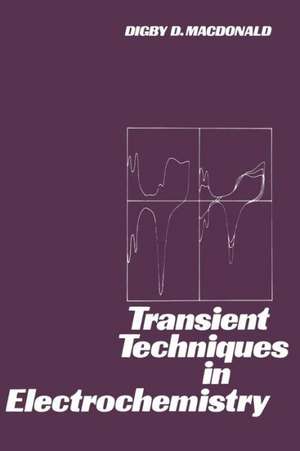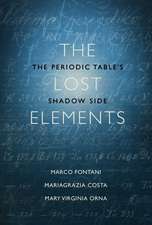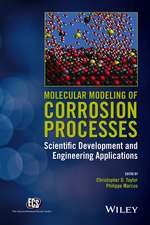Transient Techniques in Electrochemistry
Editat de Digby Macdonalden Limba Engleză Paperback – 22 dec 2011
Preț: 390.84 lei
Nou
Puncte Express: 586
Preț estimativ în valută:
74.81€ • 81.29$ • 62.88£
74.81€ • 81.29$ • 62.88£
Carte tipărită la comandă
Livrare economică 21 aprilie-05 mai
Preluare comenzi: 021 569.72.76
Specificații
ISBN-13: 9781461341475
ISBN-10: 1461341477
Pagini: 344
Ilustrații: XII, 330 p.
Dimensiuni: 155 x 235 x 18 mm
Greutate: 0.48 kg
Ediția:Softcover reprint of the original 1st ed. 1977
Editura: Springer Us
Colecția Springer
Locul publicării:New York, NY, United States
ISBN-10: 1461341477
Pagini: 344
Ilustrații: XII, 330 p.
Dimensiuni: 155 x 235 x 18 mm
Greutate: 0.48 kg
Ediția:Softcover reprint of the original 1st ed. 1977
Editura: Springer Us
Colecția Springer
Locul publicării:New York, NY, United States
Public țintă
ResearchCuprins
1. Introduction.- 1.1. Why Transient Techniques?.- 1.2. The Electrical Double Layer.- 1.3. The Kinetics of Charge Transfer Processes in the Steady State.- 1.4. General Current Equation.- 1.5. Surface Heterogeneity.- 1.6. Electrochemical Adsorption and Pseudocapacitance.- 2. Experimental Methods.- 2.1. Types of Perturbation.- 2.2. Cell and Electrode Design.- 2.3. The Electronics of Electrochemistry.- 2.4. Potentiostats.- 2.5. Galvanostats.- 2.6. Transient Response.- 3. The Mathematics of Diffusion.- 3.1. Introduction.- 3.2. Fick’s Laws of Diffusion.- 3.3. Laplace Transforms.- 3.4. Laplace Transformation of Fick’s Second Law.- 3.5. Coupled Chemical/Electrochemical Processes.- 3.6. Inverse Laplace Transformation.- 3.7. Analysis in Laplace Space.- 3.8. Numerical Analysis.- 3.9. Digital Simulation.- 3.10. Analog Methods.- 4. Potential Step Chronoamperometry and Chronocoulometry.- 4.1. Introduction.- 4.2. Experimental.- 4.3. Simple Charge Transfer Reactions.- 4.4. Coupled Chemical/Electrochemical Processes.- 4.5. The Voltage Step Method.- 5. Chronopotentiometry.- 5.1. Introduction.- 5.2. Experimental.- 5.3. Simple Charge Transfer Reactions.- 5.4. Coupled Chemical/Electrochemical Processes.- 5.5. Current Reversal and Cyclic Methods.- 5.6. Other Current Wave Forms.- 6. Linear Potential Sweep and Cylic Voltammetry.- 6.1. Introduction.- 6.2. Experimental.- 6.3. Double Layer Charging.- 6.4. Simple Charge Transfer Reactions.- 6.5. Coupled Chemical/Electrochemical Processes.- 6.6. Adsorption.- 6.7. Convolution Potential Sweep Voltammetry.- 7. AC Impedance Techniques.- 7.1. Introduction.- 7.2. Experimental.- 7.3. Simple Charge Transfer Reactions.- 7.4. Coupled Chemical/Electrochemical Processes.- 7.5. Complex Plane Analysis.- 7.6. Faradaic Rectification.- 8. Surface Processes.-8.1. Introduction.- 8.2. Potentiostatic Methods (Chronoamperometry).- 8.3. Galvanostatic Techniques.- 8.4. Linear Potential Sweep and Cyclic Voltammetry.- 8.5. AC Impedance Methods.- Appendix. Integration in Laplace Space.- References.



